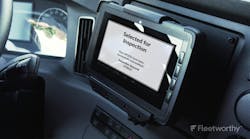The U.S. Department of Transportation’s National Highway Traffic Safety Administration recently finalized a new Federal Motor Vehicle Safety Standard to make automatic emergency braking, including pedestrian AEB, standard on all passenger cars and light trucks by September 2029. This safety standard is expected to reduce rear-end and pedestrian crashes, according to NHTSA.
NHTSA projects that this new standard, FMVSS No. 127, will save at least 360 lives annually and prevent at least 24,000 injuries annually. AEB systems use sensors to detect when a vehicle is close to crashing into a vehicle or pedestrian in front and automatically brake if the driver has not. Pedestrian AEB technology will detect a pedestrian in both daylight and at night. This will reduce injury or property damage and associated costs from these crashes.
“The new vehicle safety standards we finalized today will save hundreds of lives and prevent tens of thousands of injuries every year,” said U.S. Transportation Secretary Pete Buttigieg. “The Bipartisan Infrastructure Law is not only making historic investments in transportation, it’s also ushering in a new era of safer travel by ensuring new cars and light trucks are equipped with automatic emergency braking, making our roads safer for drivers and pedestrians alike.”
See also: Distracted driving trends up despite awareness
The new standard requires all cars to be able to stop and avoid contact with a vehicle in front of them up to 62 miles per hour, and that the systems must detect pedestrians in both daylight and darkness. In addition, the standard requires that the system apply the brakes automatically up to 90 mph when a collision with a lead vehicle is imminent, and up to 45 mph when a pedestrian is detected.
The standard fulfills a provision in the Bipartisan Infrastructure Law to establish minimum performance standards requiring that all passenger vehicles be equipped with AEB. This standard also advances the Department’s National Roadway Safety Strategy, which was launched in January 2022 to address the national crisis in traffic fatalities and serious injuries. The National Roadway Safety Strategy adopts the safe system approach and builds multiple layers of protection with safer roads, safer people, safer vehicles, safer speeds, and better post-crash care. As part of the safe system approach, this new vehicle safety standard highlights safer vehicles and USDOT’s effort to expand vehicle systems and features to help prevent crashes.



